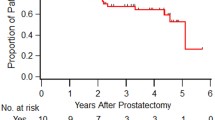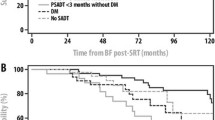Abstract
Purpose
Primary androgen deprivation therapy (PADT) is an important treatment modality for men with localized or locally advanced prostate cancer and without bone metastasis. There is, however, a lack of data on the biochemical relapse (BR) outcomes in these patients. Here, we studied the outcome of a contemporary series of men treated by PADT and investigated predictive risk factors for BR.
Methods
One hundred and fifty-five patients treated by PADT formed the initial study cohort, and BR outcomes in this group were reviewed. The outcomes of men with bone scan negative disease were specifically analysed. The predictive value of a panel of clinical risk factors for BR was evaluated using univariate and multivariate analysis. The results were further validated in a separate cohort of patients without bone metastasis from a second institution (n = 84).
Results
Median follow-up was 70 months. In the first study cohort, 109/155 men (70%) had bone scan negative disease. In these patients, only 45% developed BR during the follow-up period with only 28% relapsing within 5 years of initiating PADT. Key-independent factors predicting BR were a high PSA nadir (p = 0.001) and a shorter time to nadir (p < 0.001). A nadir of ≤0.1 ng/ml and time to nadir of >24 months specifically identified men with a very good outcome from PADT. In a second-independent cohort, very similar overall and 5-year BR rates were observed in men without bone metastasis (39 and 35%, respectively). PSA nadir thresholds identified in the first cohort were again able to define a good prognostic group in this re-test cohort (p = 0.005 and p = 0.01, respectively).
Conclusion
Men treated by PADT and without bone metastasis can have very durable responses to PADT with the majority remaining BR free at 5 years. PSA nadir and time to nadir are key predictors of a good outcome in this group.



Similar content being viewed by others
References
Akaza H, Homma Y, Usami M, Hirao Y, Tsushima T, Okada K, Yokoyama M, Ohashi Y, Aso Y, Prostate Cancer Study Group (2006) Efficacy of primary hormone therapy for localized or locally advanced prostate cancer: results of a 10-year follow-up. BJU Int. 98:573–579
Benaim EA, Pace CM, Lam PM, Roehrborn CG (2002) Nadir prostate-specific antigen as a predictor of progression to androgen-independent prostate cancer. Urology: 59:73–78
Choueiri TK, Xie W, D’Amico AV et al (2009) Time to prostate-specific antigen nadir independently predicts overall survival in patients who have metastatic hormone-sensitive prostate cancer treated with androgen-deprivation therapy. Cancer 115:981–987
Cooper EH (1992) Prostate specific antigen in diagnosis, staging, and follow-up of prostate cancer. Prostate 4:125–129
Cooperberg MR, Grossfeld GD, Lubeck DP (2003a) National practice patterns and time trends in androgen ablation for localized prostate cancer. J Natl Cancer Inst 95:981–989
Cooperberg MR, Lubeck DP, Mehta SS et al (2003b) Time trends in clinical risk stratification for prostate cancer: implications for outcomes (data from CaPSURE). J Urol 170:S21–S25 (discussion S6–S7)
DiBlasio CJ, Malcolm JB, Hammett J, Wan JY, Aleman MA, Patterson AL, Wake RW, Derweesh IH (2009) Survival outcomes in men receiving androgen-deprivation therapy as primary or salvage treatment for localized or advanced prostate cancer: 20-year single-centre experience. BJU Int 104:1208–1214
Evans HS, Moller H (2003) Recent trends in prostate cancer incidence and mortality in southeast England. Eur Urol 43:337–341
Heidenreich A, Aus G, Bolla M et al (2008) EAU guidelines on prostate cancer. Eur Urol 53:68–80
Huggins C, Hodges C (1941) Studies in prostate cancer: the effect of castration, of estrogen and of androgen injection on serum phosphatases in metastatic carcinoma of the prostate. Cancer Res 1:293–297
Hussain M, Tangen CM, Higano C (2006) Absolute prostate-specific antigen value after androgen deprivation is a strong independent predictor of survival in new metastatic prostate cancer: data from Southwest Oncology Group Trial 9346 (INT-0162). J Clin Oncol 24:3984–3990
Ishikawa S, Soloway MS, Van der Zwaag R, Todd B (1989) Prognostic factors in survival free of progression after androgen deprivation therapy for treatment of prostate cancer. J Urol 141:1139–1142
Janoff DM, Peterson C, Mongoue-Tchokote S et al (2005) Clinical outcomes of androgen deprivation as the sole therapy for localized and locally advanced prostate cancer. BJU Int 96:503–507
Kawakami J, Cowan JE, Elkin EP, Latini DM, DuChane J, Carroll PR, CaPSURE Investigators (2006) Androgen-deprivation therapy as primary treatment for localized prostate cancer: data from Cancer of the Prostate Strategic Urologic Research Endeavor (CaPSURE). Cancer 106:1708–1714
Kwak C, Jeong SJ, Park MS, Lee E, Lee SE (2002) Prognostic significance of the nadir prostate specific antigen level after hormone therapy for prostate cancer. J Urol 168:995–1000
Morote J, Trilla E, Esquena S et al (2004) Nadir prostate-specific antigen best predicts the progression to androgen-independent prostate cancer. Int J Cancer 108:877–881
Morote J, Esquena S, Abascal JM et al (2005) Usefulness of prostate-specific antigen nadir as predictor of androgen-independent progression of metastatic prostate cancer. Int J Biol Markers 20:209–216
North and Yorkshire Cancer Registry and Information Service. http://www.nycris.nhs.uk
Oefelein MG, Ricchiuti VS, Conrad PW et al (2002) Clinical predictors of androgen-independent prostate cancer and survival in the prostate-specific antigen era. Urology 60:120–124
Schally AV (2007) Luteinizing hormone-releasing hormone analogues and hormone ablation for prostate cancer: state of the art. BJU Int 100(Suppl 2):2–4
Shahinian VB, Kuo YF, Freeman JL, Orihuela E, Goodwin JS (2005) Increasing use of gonadotropin-releasing hormone agonists for the treatment of localized prostate carcinoma. Cancer 103:1615–1624
Sharifi N, Gulley JL, Dahut WL (2005) Androgen deprivation therapy for prostate cancer. JAMA 294:238–244
Soloway MS, Ishikawa S, van der Zwaag R, Todd B (1989) Prognostic factors in patients with advanced prostate cancer. Urology 33:53–56
Wilson DW, Harper ME, Jensen HM et al (1985) A prognostic index for the clinical management of patients with advanced prostatic cancer: a British Prostate Study Group investigation. Prostate 7:131–141
Acknowledgments
Work supported by Cancer Research UK.
Conflict of interest statement
The authors declare that they have no conflict of interest in this study.
Author information
Authors and Affiliations
Corresponding author
Additional information
S. Hori and T. Jabbar are the joint first authors.
Rights and permissions
About this article
Cite this article
Hori, S., Jabbar, T., Kachroo, N. et al. Outcomes and predictive factors for biochemical relapse following primary androgen deprivation therapy in men with bone scan negative prostate cancer. J Cancer Res Clin Oncol 137, 235–241 (2011). https://doi.org/10.1007/s00432-010-0877-9
Received:
Accepted:
Published:
Issue Date:
DOI: https://doi.org/10.1007/s00432-010-0877-9




